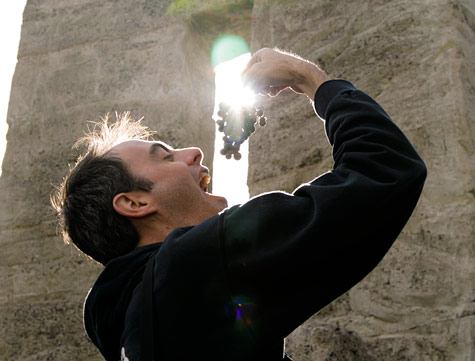Archive for July, 2011
Update 2010: The good
 Part Two of your 2010 update…
Part Two of your 2010 update…
Cabernet Sauvignon
The Cab in particular betrayed a self-destructive love of the EA (ethyl acetate) this year, so we’ve had to carpet bomb it with sulfite to jerk it back onto the straight and narrow. The good news is that it now appears to be EA-free, and as it emerges from beneath its heavy blanket of sulfite, it seems pretty nice, though still hard to get a clear sense of.
The EA problem also had at least one downstream consequence: some of the Cab is pretty dang oaky. That’s because the EA was particularly bad in our half barrel, so we (I think wisely) quarantined it until it was cured. But as a result, because that half barrel was new, the Cab therefore soaked up more new oak than we’d normally have liked.
I don’t think it’s a disaster by any means, but as a general rule, our philosophy is that oak should be like salt in food — if you notice it, you’ve put in too much. This year, whether we like it or not, we’ll see what happens when we’re forced to ignore that rule. The downside is oaky, woody vanillin potentially dominating; the upside, though, is more tannic backbone than we’re used to, so it’ll be very instructive to see how that unfolds over time. (How’s that for “[wine] glass half-full” take on things!?)
Merlot
I know: to sum up this wine’s life story as “it is what it is”, as I did earlier, is unfair and probably a little lazy, too — fashion has made looking down on Merlot way too easy. Nevertheless, this year’s Merlot is exactly that — Merlot — an amiable, good-natured wine that offers great companionship with little complication. We’ve lowered our harvest of this grape over the years, mostly because its part in the Peugeot blend has dropped over time, but I for one still enjoy it. There’s something comforting about a wine waiting for you when you get home on a weekday, wagging its tail with unconditional love. Who else is so glad to see you every time? Not that Cabernet, anyway — at least for now…
Next, the problem children…
No comments2010 Update: the pretty damn good
As promised in a few days ago, here’s the next installment of how our 2010 wines are faring. We begin with dessert: the wines that really seem like they’ll be excellent — assuming we let them make it to bottle and don’t gleefully guzzle them right now.
Cabernet Franc
We like to rack the Franc only two or three times over the year, supposing that minimal handling will help preserve its bewitching aroma. One of those rackings was a few weeks ago, and like a saucy mermaid, it beckoned us with a irresistible floral nose, and then lured us ever-further into the depths with succulent, floral fruit. Wow. Once again, this will be both hard to blend away and deservedly form the backbone of the Peugeot.
Syrah
I’ve opened two 2009 Syrahs in the last couple of weeks, and holy crap, this is the most adult wine I think we’ve ever made: deep and powerful but unmistakably syrah (vs. liquid oak with varietal flavoring, as many are). The 2010 looks to be a good follow-up, but with better acidity and rich, crisply-articulated fruit resonating through great depth. Awesome.
Grenache
This is the first year we’ve tried Grenache, and typical of our sober, judicious approach to winemaking, we blindly hurled ourselves over the edge, investing heavily. Luckily, it paid off: when we racked it about a month ago, its aroma was as bewitching as the Franc’s, but more luscious and Provençal-herby. Thankfully, we’ll have enough to bottle separately and cast in our first Côtes-du-Rhône blend this year. It’ll be one stunning leading lady in that road show.
Mourvedre
We pressed this varietal into service for the first time this year as the third leg of a Côtes-du-Rhône stool, but to our suprise, it stands on its own just fine, thank you. Inky dark, and redolent of pepper and roses. Holy moley.
Pinot Noir
After three vintages working with fruit from a highly reputed Dundee Hills vineyard, our Pinot this year is finally beautiful — if willowy. Since this varietal totally ate our lunch in the 90s, we’ve been pretty gun-shy about it: as with white wines, its essential delicacy means there are fewer places to hide crappy fruit or bad winemaking, both of which we had in ample supply back in the day. As a result, for the last few years we’ve only produced small batches as “side-bets” for the braver Garagistes.
This year, I’m proud to report, it looks like that bet will pay off, in part because we’re better winemakers, but more importantly, because we’re working with better fruit. Of course, 2010 was a lighter vintage in Oregon — no Parker wines this year without heavy manipulation — and our Pinot is no anomaly. But it’s not watery or bland. It’s just… elegant, with beautiful, focused fruit. We put a little oak on it a month ago (just a little), so by the time we bottle it in September, it ought to be really lovely.
No commentsSummer Garagistes update
 Harvest 2011 is just now visible on the horizon, and the prospect of a fresh river of juice has similarly quickened this blog out of its traditional winter/spring slumber. [yawn] Good morning! What did we miss?
Harvest 2011 is just now visible on the horizon, and the prospect of a fresh river of juice has similarly quickened this blog out of its traditional winter/spring slumber. [yawn] Good morning! What did we miss?
Quite a bit, as it turns out. Despite the radio silence here at Les Blog, we’ve actually been busy little microbes downstairs, racking wines, adjusting this and that, and rigorously sampling our wares to ensure top quality (oh, was that what we were doing?). As a result, I have a few reports to share with you over the next few days on how all the varietals in our stable downstairs are faring:
- Cabernet Sauvignon
- Merlot
- Cabernet Franc
- Syrah
- Mourvedre
- Grenache
- Pinot Noir
- Viognier
- Rosé (of Grenache)
Overall, I think this vintage has produced truly excellent wines, primarily because the late, cool harvest meant higher acidity in just about everything. So the wines have structure and liveliness straight off the vine, and that I think will make this year’s crop arguably one of the best we’ve ever overseen.
But for scientific reasons I only dimly understand, the vintage also presented its share of problems, in particular a low-level epidemic of EA (ethyl acetate – think nail polish remover) through a number of the wines. Thanks to great advice from friends who are real winemakers, and some timely intervention on our part, all of our wines muscled through the EA and are now perfectly sound, but WTF? You’d think those higher acidities would afford some protection, but that EA must have tunneled in through the basement of the flower shop next door or something…
Anyway, based on where things taste now, I can say this: the 2010 Cabernet Franc, Grenache, Mourvedre, and Syrah will be utterly stunning. The Pinot Noir will also be lovely and elegant, though reflective of the lighter vintage. The Cabernet Sauvignon is a bucking, unruly stallion I don’t think we’ve quite tamed yet, but we will. The Merlot is… Merlot. The Viognier will also be lovely, but very… crisp, as the wine industry likes to spin high-acid wines. And the Rosé — man, it may yet excel, but it’s one sullen teenager.
So on the eve of blending trials, our wines fall into three categories: great, good, and problematic. Next up in a day or so, more on the great, followed in due course by reports on the other two.
No comments

